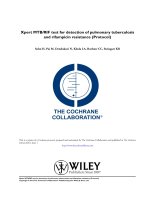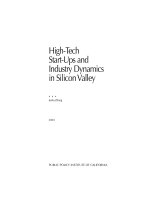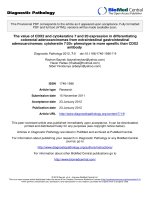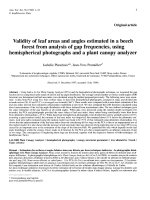Detection of high level aminoglycoside resistance and vancomycin resistance in Enterococcus species isolated from various clinical samples of tertiary care medical college hospital
Bạn đang xem bản rút gọn của tài liệu. Xem và tải ngay bản đầy đủ của tài liệu tại đây (336.34 KB, 9 trang )
Int.J.Curr.Microbiol.App.Sci (2017) 6(5): 2731-2739
International Journal of Current Microbiology and Applied Sciences
ISSN: 2319-7706 Volume 6 Number 5 (2017) pp. 2731-2739
Journal homepage:
Original Research Article
/>
Detection of High Level Aminoglycoside Resistance and Vancomycin
Resistance in Enterococcus Species Isolated from Various Clinical Samples of
Tertiary Care Medical College Hospital
S. Rajesh1*, N. Subathra2, D.Neelaveni3 and S. Nirmala4
Department of Microbiology, Government Mohankumaramangalam Medical College,
Salem, India
*Corresponding author:
ABSTRACT
Keywords
Aminoglycoside
Resistance and
Vancomycin
Resistance,
Enterococcus
Article Info
Accepted:
26 April 2017
Available Online:
10 May 2017
Enterococci are the most common aerobic and facultative anaerobic, gram positive cocci.
They constitute a part of the normal intestinal flora. However they also occupy other sites
such as oral cavity, GUT, skin etc. Enterococci, which earlier considered as low grade
pathogens, has now emerged as one of the most important nosocomial pathogens
worldwide and are associated with high mortality. Enterococci sp have been emerged as
one of the most important cause of nosocomial infections. The main sites of colonization
in the hospitalized patients are soft tissue wounds, ulcers and GIT. Enterococcus species
of group D streptococcus mainly associated with urinary tract infection and pelvic
infection and intra abdomen sepsis and wound infection and produce septicaemia and
endocarditis. In contrast to other streptococcus, Enterococcus produces intrinsically
resistance to many of antibiotics like cephalosporins and low concentration penicillin. The
samples are collected from the outpatients and inpatients of Govt. Mohan
Kumaramangalam Medical College Hospital. The isolated Enterococci are then tested
for routine antibiotic sensitivity over Mueller Hinton agar in a lawn culture by Kirby Bauer
Disc diffusion technique. The diffusion discs loaded with antibiotics - high level
gentamycin (120µg) and high level streptomycin (300µg) are placed over the medium
along with other antibiotics (CLSI 2016). The zone of inhibition is noted in them. A total
of 3400 samples were collected from the in and out patient departments of Govt. Mohan
Kumaramangalam Medical College Hospital. Of these, 52 samples were positive for
Enterococci. Among 52 Enterococcus species 40 species are Enterococcus faecalis and
only 12 species are Enterococcus faecium. Most of the isolates are from urine (23/52)
followed by blood samples (16/52). 9/52 are from pus samples. Other sites where positive
growth obtained are from ear swab (2/52) and vaginal swab (1/52) and none of the body
fluids shown growth in this study. Muti drug resistant Enterococcus infection is very
difficult to treat with single antibiotic like penicillin or ampicilline alone and need to treat
infection in combination with high level genta or amikacin with adequate dosage and
duration to be needed. Linzolid and vancomycin like antibiotics are very effective in
treatment of enterococcal septicaemia and endocarditis but resistant to use vancomycin and
deptomycin, linzolid like antibiotics only in culture proven enterococcal infection.
Indiscriminate use of vancomycin antibiotics leads to vancomycin resistance Enterococcus
infection. Proper infection control practice prevents nosocomial enterococcal infection.
Proper screening of urine sample and
wound sample and csf and ascetic fluid for
Enterococcus with appropriate culture media and staining techniques and earlier isolation
and antibiotic sensitivity testing can prevent mortality due to enterococcal infection.
2731
Int.J.Curr.Microbiol.App.Sci (2017) 6(5): 2731-2739
Introduction
Enterococci are the most common aerobic
and facultative anaerobic, gram positive
cocci. They constitute a part of the normal
intestinal flora. However they also occupy
other sites such as oral cavity, GUT, skin etc.
Enterococci, which earlier considered as low
grade pathogens, has now emerged as one of
the most important nosocomial pathogens
worldwide and are associated with high
mortality.
The main sites of colonization in the
hospitalized patients are soft tissue wounds,
ulcers and GIT. Over the years the
Enterococci have become increasingly
resistant to antibiotics in terms of both
multiplicity of resistance and level of
resistance to a particular drug (Sieńkoe et al.,
2014; Triveda and Gomathi, 2016; Luna
Athigari, 2010). Enterococcus species of
group D Streptococcus mainly associated with
urinary tract infection and pelvic infection
and intra abdomen sepsis and wound infection
and produce septicaemia and endocarditis.
In contrast to other Streptococcus,
Enterococcus produces intrinsically resistance
to many of antibiotics like cephalosporins and
low concentration penicillin like cell wall
active antibiotics which are mainly used for
treatment of other Streptococcus infection.
Enterococcus is also resistance to low
concentration aminoglycoside like amikacin
and gentamycin and shows sensitive only to
high level of aminoglycosides. Enterococcus
extrinsically resistant to high concentration of
ampicilline and high level aminoglycosides
and ciprofloxacin due to betalactamase
enzyme production and plasmid mediated
gene transfer mechanisms and through
transporans. Due to multi drug resistance
Enterococcus infections are very difficult to
treat. Enterococci are intrinsically resistant to
cell wall active agents like penicillin,
Ampicillin if used alone. They are also
inherently or intrinsically resistant to other
antibiotics such as Cephalosporins and
Aminoglycosides. This type of resistance is
due to loss of affinity to PBPs in case of cell
wall active agents and reduced uptake of
antibiotic as in case of AGs.
If any of those antibiotics when used alone,
resulting in treatment failure. To overcome
these resistance, various combination
therapies have been used combining an
Aminoglycoside antibiotic with one of the
cell wall active agents. These combination
leads to synergism known as enhanced killing
of organism by the drugs (Gangurde et al.,
2014).
The common regime for treatment for serious
Enterococcus infections such as septicemia is
combination of cell wall inhibitors such as
penicillin, ampicillin or vancomycin with
aminoglycosides such as gentamicin and
Amikacin.
The addition of cell wall inhibitor agents
helps in penetration of aminoglycosides into
the bacterial cytoplasm making intrinsically
resistant organism as aminoglycoside
sensitive (Wei Jia et al., 2014). This study
will provide data on the prevalence of High
Level Aminoglycoside Resistance among
Enterococci species and determine the
usefulness of combination therapy with cell
wall active agents to treat serious
Enterococcal infections like meningitis,
endocarditis and septicemia
The main aim and objectives of this study
includes, isolating and identifying the
Enterococcus bacteria from various clinical
samples and detecting the High Level
Aminoglycoside Resistance (HLAR) among
Enterococcus isolates. Also to assess the
usefulness of combination therapy of
Aminoglycosides with cell wall active
antibiotics to treat serious enterococcal
infections.
2732
Int.J.Curr.Microbiol.App.Sci (2017) 6(5): 2731-2739
Materials and Methods
Methods of data collection
Study design and type: Prospective study
Study population: Male and Female patients
of all age groups from various in and
outpatient departments
Place of Study: Department of Diagnostic
Microbiology,
Govt.
Mohan
Kumaramangalam Medical College, Salem
District, Tamilnadu
Period of study: Six months (June 2016 –
November 2016)
Sample size: 3400
Sample Selection criteria: All pus samples,
urine samples, blood samples, body fluids
(Pleural, Peritoneal) and CSF
Sample Exclusion Criteria: samples from
respiratory system and from GI system as
Enterococci occur as normal commensals in
these sites
Methodology
The samples are collected from the
outpatients and inpatients of Govt. Mohan
Kumaramangalam Medical College Hospital.
The samples are cultured over basal medium
nutrient agar, McConkey agar without crystal
violet and enriched medium such as blood
agar. The Enterococcus sp. are identified by
Gram staining morphology, 3% catalase test
and confirmed by Salt tolerance test (growth
in 6.5% Nacl), Bile aesculin hydrolysis and
heat test. Speciation of Enterococci were
carried out by Facklam’s and Collin’s
conventional method. Growth of black
colonies on 0.04% Potassium tellurite agar
and fermentation of sorbitol, mannitol sugars
but not arabinose were identified as
E.faecalis. Fermentation of arabinose but not
sorbitol without potassium tellurite reduction
was identified as E. faecium (Facklam and
Collins, 1989). The isolated Enterococci are
then tested for routine antibiotic sensitivity
over Mueller Hinton agar in a lawn culture by
Kirby Bauer Disc diffusion technique. The
diffusion discs loaded with antibiotics - high
level gentamycin (120µg) and high level
streptomycin (300µg) are placed over the
medium along with other antibiotics (CLSI
2016). The zone of inhibition is noted in
them. For HLAR, the resistance is indicated
as no zone and susceptibility as zone of
diameter greater than 10mm. Strains with
inhibition 7-9mm are considered as
inconsistent. All media and antibiotic discs
are purchased from Hi Media Laboratories,
Mumbai.
Results and Discussion
A total of 3400 samples were collected from
the in and out patient departments of Govt.
Mohan kumaramangalam Medical College
Hospital. Of these, 52 samples were positive
for Enterococci. Among 52 Enterococcus
species 40 species are Enterococcus faecalis
and only 12 species are Enterococcus faecium
(Table.3). Most of the isolates are from urine
(23/52) followed by blood samples (16/52).
9/52 are from pus samples. Other sites where
positive growth obtained are from ear swab
(2/52) and vaginal swab (1/52). None of the
body fluids showed growth in this study
(0/52) (Table 1).
All 52 isolates were screened for HLG and
HLS resistance. 7/52 strains showed High
Level Aminoglycoside resistance. Of which 4
showed only HLG resistance; HLS resistance
is observed in 2 isolates and one isolate shows
resistance to both (Table 2).
Table 3 shows general antibiotic sensitivity
pattern of enterococcal isolates in which
2733
Int.J.Curr.Microbiol.App.Sci (2017) 6(5): 2731-2739
highest sensitivity is shown by linezolid
(51/52) followed by vancomycin (47/52). The
sensitivity of Amoxy-clauv and Ampicillin is
around
40%.
For
urinary
isolates
nitrofurantoin shows highest (96%) sensitivity
and sensitivity of Norfloxacin is poor (25%).
Doxycycline shows good spectrum of action
(85%) when compared to Ampicillin,
Amoxyclav and erythromycin.
The Enterococcus bacteria are inherently
resistant to the antibiotics in regular usage
such as Low level aminoglycosides and cell
wall inhibitors. Hence it is a challenging task
to handle the Enterococcus species.
In most of the studies in India (Niharika et al.,
2014; Jyotsna Agarwal et al., 2009), the
maximum number of isolates were recovered
from urine samples, blood samples followed
by pus swab. The present study also showed
that maximum number of isolates were from
urine samples (44%) followed by blood
samples (31%) and pus swabs (17%).
In our study maximum isolate from
urine(44%) and blood(31%) but Enterococcus
isolation in blood is more in number as
compared to other study (Sieńkoe et al., 2014)
and Mendiratta et al., 2008). In contrast to
most of the recent studies conducted in India
(Narayan srihari et al., 2011; Niharika et al.,
2014), The HLAR resistance pattern in the
present study is low, only 14% when
compared (50-90% in other studies), The
HLGR alone is 8%, HLSR alone is 4% and
2%
show
both
type
resistances
simultaneously. In a study comprising 27
European countries by Schoutan et al.,(1999)
the HLGR prevalence rate varied from149%.high level gentamycin resistance also is
very less (14%) as compared to other study
(Sivasankari et al., 2013)
In our study shows, more number of 40
Enterococcus faecalis (76.9%) as compared
to 12 Enterococcus faecium (23.1%). it is
similar to other study like Gangurde et al.,
(2014) and Latika et al., (2012). But some of
studies shows more number of Enterococcus
faecium and less number of Enterococcus
faecalis (Wei Jia et al., 2014) Ampicillin
resistance is only 33 % as compared to other
study (Mitrakhani et al., 2016) it is very less
in number only. More than 50% of isolates
are resistant to Ampicillin, Amoxyclav,
ciprofloxacin and Erythromycin in the present
study. This is comparable with other recent
studies (Narayan Srihari et al., 2011, Adhikari
et al., 2010).
Table.1 Percentage of Enterococcus isolates
Samples
Enterococci Isolated
Pus
9
Sputum
1
Blood
16
Urine
23
Ear swab
2
Vaginal swab
1
Body fluids*
0
Total
52
*Denotes CSF, Pleural and Peritoneal fluids
2734
Percentage (%)
17.3%
2.0%
30.8%
44.2%
4.0%
2.0%
0
Int.J.Curr.Microbiol.App.Sci (2017) 6(5): 2731-2739
Table.2 High Level Aminoglycoside Resistance among Enterococci
.
Drug
Resistance (n=52) Percent
High Level Gentamycin (120 µg)
4
8%
High Level Streptomycin (300 µg)
2
4%
Both HLG and HLS
1
2%
Table.3 Distribution of enterococcus species
Species identified
E. faecalis
Number (n=52)
40
Percentage
76.9 %
E. faecium
12
23.1%
Total
52
100 %
Table.4 Antibiotic Sensitivity Pattern of Enterococcus to other antibiotics
Antibiotic used
Sensitive (%)
N = 52
Resistant (%)
Ampicillin (10 µg)
19 (36.5)
33 (63.5)
Ciprofloxacin (5µg)
29 (55.8)
23 (44.2)
Norfloxacin# ( n=23)
6 (26)
17 (74)
Nitrofurantoin* (30µg) (n=23)
22 (95.7)
1 (4.3)
Doxycycline (30 µg)
44 (84.6)
8 (15.4)
Amoxyclauv
22 (42.3)
30 (57.7)
Erythromycin (15 µg)
24 (46.2)
28 (53.8)
Vancomycin (30µg)
49 (94.3)
5 (5.7)
Linezolid (30µg)
51 (98)
1 (2)
#, * used for urinary isolates only
2735
Int.J.Curr.Microbiol.App.Sci (2017) 6(5): 2731-2739
Fig.1 Percentage of Enterococci in clinical samples
% OF ENTEROCOCCI
50
44.2
45
40
35
30.8
30
25
20
17.3
15
10
4
Fig.2 Distribution of High Level Aminoglycoside resistance
% OF HLAR
0
2
4
8
HLGR
HLSR
According to our study the highest sensitivity
pattern is shown by Linezolid (98%) followed
by vancomycin (94%) for all samples and for
urinary isolates nitrofurantoin shows high
sensitivity (96%) as observed in other studies.
(Suresh et al., 2013; Agarwal et al., 2009;
1999).
Prevalence
of
Vancomycin
Resistant
Enterococci (VRE) by disk diffusion method
HLSR & HLSR
varies about 0-6.5% from various studies
(Jyostna Agarwal et al., 2009). In the present
study the incidence of VRE is 5.7% that is to
be noted. Vancomycin resistance is only 5
%.it is less as compared to Sieńkoe et al.,
(2014) study shows 24%
Both Enterococcus faecalis and faecium
shows equal range of drug resistance as
compared to other study which shows more
2736
Int.J.Curr.Microbiol.App.Sci (2017) 6(5): 2731-2739
resistance seen only in faecium.
In conclusion, this study presents an antibiotic
sensitivity pattern of Enterococcus isolates
with special emphasis on prevalence of High
Level Aminooglycoside Resistance (HLAR).
According to present study, HLAR pattern is
low (14%) in our area of Salem District,
Tamilnadu when compared to other parts of
India.
Muti drug resistant Enterococcus infection is
very difficult to treat with single antibiotic
like pencillin or ampicilline alone and need to
treat infection in combination with high level
genta or amikacin with adequate dosage and
duration to be needed. linzolid and
vancomycin like antibiotics very effective in
treatment of enterococcal septicaemia and
endocarditis but restrict to use vancomycin
and daptomycin, linzolid like antibiotics only
in culture proven enterococcal infection.
Indiscriminate use of vancomycin antibiotics
leads to vancomycin resistance Enterococcus
infection.
Proper infection control practice prevent
nosocomial enterococcal infection. Proper
screening of urine sample and wound sample
and csf and ascetic fluid for Enterococcus
with appropriate culture media and staining
techniques and earlier isolation and antibiotic
sensitivity testing can prevent mortality due to
enterococcal infection. In the present study
the second most common enterococcal
infection is neonatal septicaemia which is one
of the serious enterococcal infections in
which combination therapy of AGs and cell
wall active antibiotics would definitely be
yielding successful treatment outcomes. For
treating serious enterococcal infections single
drug therapy with Linezolid or vancomycin is
very effective and Nitrofurantoin effective in
urine samples and for wound infections
doxycycline can be tried.
At the same time, even the incidence of
Vancomycin resistance is low (5.7%) by disk
diffusion method when compared to other
studies which mandates routine screening of
VRE in our set up.
The greater understanding of mechanisms of
antibiotic action and resistance pattern offers
a hope on development of new therapeutic
targets and hence helps the physician as well
as the patient in better treatment of emerging
resistant isolates.
Enterococcus infections are mainly associated
with nosocomial infection and increase
incidence mainly due to indiscriminate use of
broad spectrum antibiotics. Proper infection
control practice need to prevent nosocomial
origin of entrococci.
References
Agarwal V.A. Jain Y.I., Pathak A.A.
Concomitant high level resistance to
penicillin and aminoglycosides in
Enterococci at Nagpur, Central India.
Indian J Med Microbiol 1999;17: 857.
Bhat KG, Paul C, Bhat MG. High level
aminoglycoside
resistance
in
Enterococci isolated from hospitalized
patients.Indian J Med Res 1997; 105:
198-9.9.
Facklam RR, Collins MD. Identification of
Enterococcus species isolated from
human infections by conventional test
scheme J Clin Microbiol 1989;
24:731-4.
Gangurde N, Mane M, Phatale S. Prevalence
of Multidrug Resistant Enterococci in
a Tertiary Care Hospital in India: A
Growing Threat. Open J. Med.
Microbiol., 2014;4:11-15.
Jyotsna Agarwal, Rajkumar Kalyan, and
Mastan
Singh.
High-Level
Aminoglycoside
Resisance
in
Enterococci in tertiary care hospitals.
Jpn. J. Infect. Dis., 62, 158-159, 2009
2737
Int.J.Curr.Microbiol.App.Sci (2017) 6(5): 2731-2739
Latika
et al., 2012. Pervalence of
Enterococcus with high resistance
level. Open journal of medical
microbiology, Volume 2 Issue 1.
Luna Athigari. High-level Aminoglycoside
Resistance and Reduced Susceptibility
to Vancomycin in Nosocomial
Enterococci. J Glob Infect Dis. 2010
Sep-Dec; 2(3): 231–235.
Marothi, Y.A., H Agnihotri, D Dubey.
Enterococcal
resistance
–
An
overview. Indian Journal of Medical
Microbiology, (2005) 23(4):214-9.
Mendiratta, D.K., Kaur, H., Deotale, V.,
Thamke, D.C., Narang, R. and
Narang, P. (2008) Status of High
Level
Aminoglycoside
Resistant
Enterococcus
Faecium
and
Enterococcus Faecalis in a Rural
Hospital of Central India. Indian
Journal of Medical Microbiology, 26,
369-371. 10.4103/
0255-0857.43582
Mundy LM, Sahm DF, Gilmore M.
Relationship between Enterococcal
virulence and antimicrobial resistance.
Clin. Microbiol. Rev., 2000; 13: 51322.
Narayan Shrihari, Kumudini T.S, S.G.
Karadesai
and
S.C.
Metgud.
Speciation of enterococcal isolates and
antibiotic susceptibility test including
high level aminoglycoside resistance
and minimum inhibitory concentration
for vancomycin. Int J Biol Med
Res.2011; 2(4): 865-869.
Niharika Lall, Silpi Basak. High level
aminoglycoside
resistant
Enterococcus species: A study. Int J
Cur Res Rev. 2014; 06(03).
Purva Mathur, Arti Kapil, Rachna Chandra,
Pratibha
Sharma
&
Bimal
Das.Antimicrobial
Resistance
in
Enterococcus fecalis in tertiary care
hospital in North India.Indian J Med
Res 118, July 2003, pp 25-28
Randhawa, V.S., L. Kapoor, V. Singh & G.
Mehta. Aminoglycoside resistance in
Enterococci isolated from pediatric
septicemia in tertiary care hospital.
Indian J Med Res 119 (Suppl) May
2004, pp 77-79
Sarika Jain, Ashwani kumar, Bineeta kashyap
and
Iqbal
R
Kaur.
Clinico
epidemiological profile and High level
Aminoglycoside
resistance
in
enterococcal septicemia from a
tertiary care hospital in Delhi. Int J of
Applied and Basic Medical Research,
Jul- Dec 2011; Vol 1, Issue 2.
Schouten MA, Voss A, Hoogkamp-Korstanje
JAA and the European VRE study
group. Antimicrobial susceptibility
patterns of Enterococci causing
infections of Europe. ANtimicrob
Agents Chemother 1999; 43: 2542-6.
Seema Sood, Meenakshi Malhotra, B.K. Das
& Arti Kapil. Enterococcal infections
and antimicrobial resistance. Indian J
Med Res 128, August 2008, pp 111121
Sieńko A., Wieczorek P., Wieczorek A.,
Sacha P., Majewski P., Ojdana D.,
Michalska A., Tryniszewska E. 2014.
Occurrence
of
high-level
aminoglycoside resistance (HLAR)
among Enterococcus species strains.
Prog Health Sci., Vol 4,
Sivasankari et al., 2013. Prevalence of hlar
Enterococcus in tertiary care hospital.
J. Pharm. Biol. Sci., Vol 8.
Sivasankari S, Somasunder V M, Senthamarai
S, Anitha C, Kumudhavalli MS and
Suneel kumar reddy A. IOSR Journal
of pharmacy and Biological Sciences
2013 Nov-Dec; Vol 8, Issue 11
Stevenson KB, Murray EW, Sarubbi FA.
Enterococcal meningitis: Report of
four cases and Review. J Clin Infect
Dis. 1994; 18:233-239.
Suresh et al.,. Isolation, Speciation and
determination
of
high
level
2738
Int.J.Curr.Microbiol.App.Sci (2017) 6(5): 2731-2739
aminoglycoside
resistance
of
Enterococci. National Journal of Lab
Medicine.2013; vol 2 (1): 12-15.
Triveda, L., S. Gomathi. High Level
Aminoglycoside
Resistance
in
Enterococcus Species Isolated from
Tertiary Care Hospital of South India An Update. IJHSR. 2016; 6(7): 144147
Wei Jia, Gang Li and Wen Wang. 2014.
Prevalence
and
Antimicrobial
Resistance of Enterococcus Species: A
Hospital-Based Study in China. Int. J.
Environ. Res. Public Health, 11(3),
3424-3442. doi:10.3390/ijerph110303
424.
How to cite this article:
Rajesh, S., N. Subathra, D. Neelavani and Nirmala, S. 2017. Detection of High Level
Aminoglycoside Resistance and Vancomycin Resistance in Enterococcus Species Isolated from
Various
Clinical
Samples
of
Tertiary
Care
Medical
College
Hospital.
Int.J.Curr.Microbiol.App.Sci. 6(5): 2731-2739. doi: />
2739









